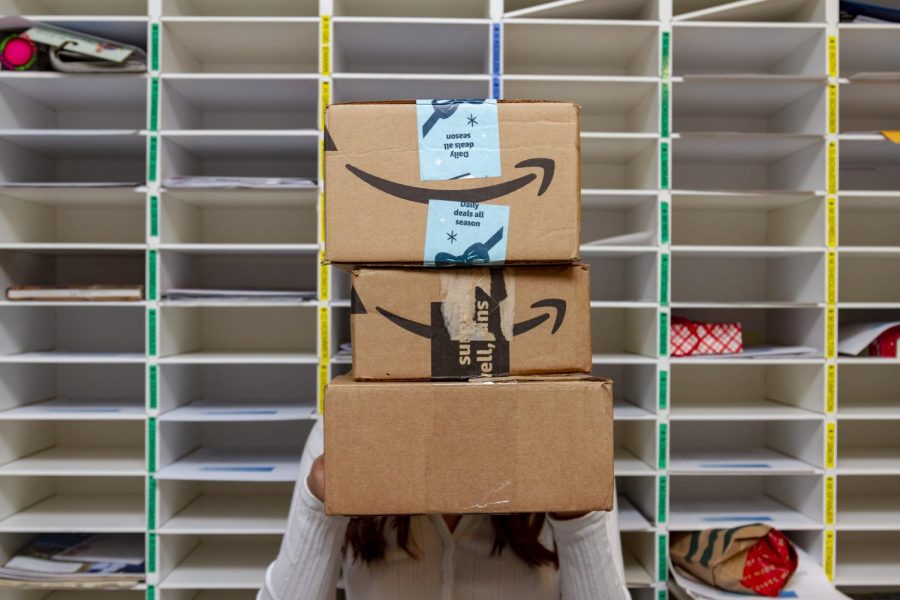Tips for an Environmentally-Friendly Holiday Season
Decking the halls is great for holiday spirit, but not so good for the environment.
On average, Americans produce 25% more waste between Thanksgiving and New Years. This equates to an additional 7 million pounds of waste each year.
December 11, 2019
For most, the holiday season represents a joyful time for celebrating with friends and family or practicing old traditions, like baking favorite dishes or adorning homes with cheery lights and wintry decorations. However, one issue that most people don’t associate with the winter holidays is the mass amount of waste produced during this time of year.
According to the Centers for Disease Control and Protection, Americans throw away 25% more trash between Thanksgiving and New Year’s Eve, adding up to an additional 7 million pounds of waste.
Being environmentally friendly is important year-round, but it is especially significant to consider the environment during the holiday season.
If every American family wrapped just three gifts in recycled materials, the United States would save enough paper to cover 45,000 football fields. By altering even just one of the ways you celebrate the holidays, your family could reduce waste and emissions to help the environment.
Below are a few tips on how to celebrate the holidays in a more environmentally-friendly way.
1. Gifting sustainably
Exchanging presents with friends and family is a popular holiday tradition; however, about 35% of Americans have an unused gift sitting in a closet at home that will likely end up in a landfill.
To prevent your gifts from contributing to waste, try giving an experience rather than a material gift. Some fun experiences you could give include tickets to a concert or a sporting event, or a membership to a museum.
If you are insistent on gifting objects, consider buying from a thrift shop or a local store rather than a larger chain or department store. Larger stores tend to have greater carbon footprints than local stores due to excess packaging and emissions from transportation. Local stores or thrift shops provide great gifts that are better for the planet.
While shopping at local shops or thrift shops is an easy way to cut down on waste, you might also consider making your own gift or regifting. Homemade gifts can be a thoughtful way to personalize your present, and there is no reason for a gift you don’t use to be sitting around at your home when someone else could be enjoying it.
2. Environmentally-friendly wrapping
According to an estimate by Earth911, the U.S. produces 4.6 million pounds of wrapping paper every year, about 2.3 million pounds of which end up in landfills.
You can reduce wrapping waste by packaging your gifts creatively, using materials like newspaper or fabric. Scarves or old maps make for unique gift-wraps, or you could try reusing old tins or gift bags.
If these creative wrapping methods don’t work for your gift, or you simply prefer using traditional wrapping paper, ensure that the paper you use is made of recycled materials. Brands like Green Field Paper Company offer a variety of different papers made with recycled paper and soy-based inks to be 100% environmentally-friendly. Look for wrapping paper that uses post-consumer recycled waste and a chemical-free treatment process.
3. Decorating sustainably
Of the many different ways to decorate during the holidays, a favorite tradition of many Americans is decorating homes with lights. According to the Center for Global Development, holiday lights on rooftops, lawns, or Christmas trees in America account for 6.63 billion kilowatt-hours of electricity — more than the electricity used by entire countries. For comparison, El Salvador uses 5.35 billion kilowatt-hours.
To reduce the electricity consumption of holiday lights, make the switch to LED lights for trees or rooftops. While a regular strand of lights uses about 34 watts, an LED strand uses around just 4 watts of electricity. You may also consider using a timer to leave holiday lights on for shorter periods of time.
Another popular but wasteful American holiday tradition is decorating homes with Christmas trees. According to Statista, in 2018, there were 32.8 million Christmas trees sold in the U.S. and 23.6 million artificial trees sold, many of which were likely discarded immediately after the holidays.
To get the most environmentally-friendly tree for the holidays, opt for a real tree, since they tend to be better for the environment than artificial trees. Christmas trees are grown as a crop in the U.S., so when each tree is chopped down, a farmer will generally plant at least one in its place. Tree farms provide habitats for wildlife and clean the air as they grow, making them beneficial for the environment. Real trees can also be recycled after the holidays, or replanted if you buy a tree with a root bulb.
On the other hand, most artificial trees for sale are manufactured with PVC or steel in China, and eventually end up in a landfill. If you are looking for the most environmentally-friendly tree, buy a live tree locally and recycle or replant it after the holidays. If a live tree is not an option for you or your family, you will want to reuse your artificial tree for at least 10-20 years before throwing it away.
As for other decorations besides lights and trees, try to avoid plastic decorations. An alternative option is crafting your own decorations, which is a fun and environmentally-friendly way to decorate your home.
4. Sustainable eating
At a time of year when many celebrate with large meals or extravagant baked goods shared with family, it is especially important to be conscious of food waste and energy consumed preparing food.
There are many ways to reduce waste from food, but among the most effective ways are planning out food consumption, making use of leftovers, and donating leftover food.
Though eating leftovers is a great solution when you prepare too much food, it is best to plan out in advance exactly how much food you will need so you have just enough for you and your family. The Guestimator, a website that is part of the Save The Food initiative, estimates the amount of food you will need to prepare by taking into account the number of guests you are serving, what type of meal you are having, and the number of leftover meals you would like.
Even when you plan your menu in advance, sometimes leftover food is inevitable. When you end up with extra food, an easy alternative to throwing it out is finding recipes that can incorporate your leftover food into news dishes. Finding these recipes is as easy as Googling the name of your food and adding “leftover recipe” to the end of your search.
Another way to avoid creating food waste is to donate leftover food to a food pantry or food bank. Urban Gleaners is a food bank based in Portland that collects food, including unserved leftovers from events. Donating leftover food is a worthwhile way to reduce food waste and support people in need in your community.
Hopefully, these tips help make your holidays merry for the planet, as well as you and your family.







Sidney Lefranc • Dec 12, 2019 at 1:23 pm
Absolutely love how the Falconer is bringing attention to staying environmentally friendly during the holidays! I will keep these tips in mind when preparing for christmas:)